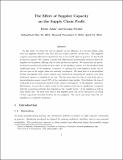| dc.contributor.author | Adida, Elodie | |
| dc.contributor.author | Perakis, Georgia | |
| dc.date.accessioned | 2016-07-19T15:25:25Z | |
| dc.date.available | 2016-07-19T15:25:25Z | |
| dc.date.issued | 2014-05 | |
| dc.identifier.issn | 0254-5330 | |
| dc.identifier.issn | 1572-9338 | |
| dc.identifier.uri | http://hdl.handle.net/1721.1/103757 | |
| dc.description.abstract | In this paper, we study the role of capacity on the efficiency of a two-tier supply chain with two suppliers (leaders, first tier) and one retailer (follower, second tier). The suppliers compete via pricing (Bertrand competition) and, as one would expect in practice, are faced with production capacity. We consider a model with differentiated substitutable products where the suppliers are symmetric differing only by their production capacity. We characterize the prices, production amounts and profits in three cases: (1) the suppliers compete in a decentralized Nash equilibrium game, (2) the suppliers “cooperate” to optimize the total suppliers’ profit, and (3) the two tiers of the supply chain are centrally coordinated. We show that in a decentralized setting, the supplier with a lower capacity may benefit from restricting her capacity even when additional capacity is available at no cost. We also show that the loss of total profit due to decentralization cannot exceed 25 % of the centralized chain profits. Nevertheless, the loss of total profit is not a monotonic function of the “degree of asymmetry” of the suppliers’ capacities. Furthermore, we provide an upper bound on the supplier profit loss at equilibrium (compared with the cooperation setting) that depends on the “market power” of the suppliers as well as their market size. We show that there is less supplier profit loss as the asymmetry (in terms of their capacities) increases between the two suppliers. The worst case arises when the two suppliers are completely symmetric. | en_US |
| dc.description.sponsorship | Singapore-MIT Alliance for Research and Technology (SMART) | en_US |
| dc.description.sponsorship | National Science Foundation (U.S.) (NSF award 0758061-CMII) | en_US |
| dc.description.sponsorship | National Science Foundation (U.S.) (NSF award 0556106-CMII) | en_US |
| dc.description.sponsorship | National Science Foundation (U.S.) (NSF award 1162034-CMMI) | en_US |
| dc.publisher | Springer US | en_US |
| dc.relation.isversionof | http://dx.doi.org/10.1007/s10479-014-1603-9 | en_US |
| dc.rights | Creative Commons Attribution-Noncommercial-Share Alike | en_US |
| dc.rights.uri | http://creativecommons.org/licenses/by-nc-sa/4.0/ | en_US |
| dc.source | Springer US | en_US |
| dc.title | The effect of supplier capacity on the supply chain profit | en_US |
| dc.type | Article | en_US |
| dc.identifier.citation | Adida, Elodie, and Georgia Perakis. “The Effect of Supplier Capacity on the Supply Chain Profit.” Ann Oper Res 223, no. 1 (May 1, 2014): 1–52. | en_US |
| dc.contributor.department | Sloan School of Management | en_US |
| dc.contributor.mitauthor | Perakis, Georgia | en_US |
| dc.relation.journal | Annals of Operations Research | en_US |
| dc.eprint.version | Author's final manuscript | en_US |
| dc.type.uri | http://purl.org/eprint/type/JournalArticle | en_US |
| eprint.status | http://purl.org/eprint/status/PeerReviewed | en_US |
| dc.date.updated | 2016-05-23T12:17:12Z | |
| dc.language.rfc3066 | en | |
| dc.rights.holder | Springer Science+Business Media New York | |
| dspace.orderedauthors | Adida, Elodie; Perakis, Georgia | en_US |
| dspace.embargo.terms | N | en |
| dc.identifier.orcid | https://orcid.org/0000-0002-0888-9030 | |
| mit.license | OPEN_ACCESS_POLICY | en_US |
